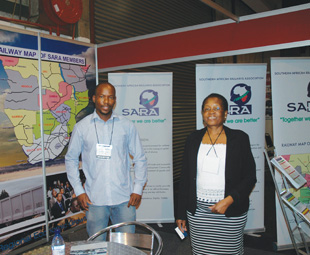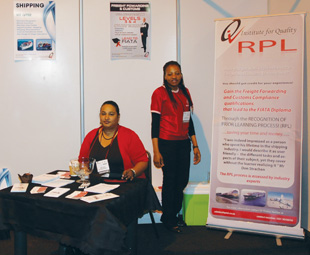Transport squared

FOCUS is moving into new territory as we branch out into rail, air and sea transport and logistics. One just needs to take a look at the TransAfrica expo to see why.
There are four basic modes of transportation being used in the world – road, rail, sea and air. Although some are thousands of years old, they are nevertheless all equally important.
Without them, civilisation as we understand it would simply not exist. Commerce, logistics, distribution – and everything else that keeps the world spinning – rely on the wheels and cogs of our transport industry grinding away smoothly.
Now, considering that there are over a billion people in Africa, making it an economic collective that has the potential to rival China and India, the importance of improving southern Africa’s rail, sea, air and road infrastructure is very clear.
Held at the Johannesburg Expo Centre from October 1 to 4, the TransAfrica expo brought together the movers and shakers from all areas of transportation and logistics in southern Africa.
 The Johannesburg Expo Centre is the largest purpose-built exhibition and event centre in South Africa and is perhaps best known to our readers as the place where the Johannesburg International Motor Show (JIMS) is held every two years (see page 22). This demonstrates the significance and size of the newly launched TransAfrica expo which was organised by Umthombo Exhibitions, Events and Promotions.
The Johannesburg Expo Centre is the largest purpose-built exhibition and event centre in South Africa and is perhaps best known to our readers as the place where the Johannesburg International Motor Show (JIMS) is held every two years (see page 22). This demonstrates the significance and size of the newly launched TransAfrica expo which was organised by Umthombo Exhibitions, Events and Promotions.
“We’re proud to introduce an expo that brings together key stakeholders and addresses the future growth and investment in transport and related infrastructure in Africa,” says Gary Corin, director of Umthombo. “The three-day conference was designed to advance knowledge and bridge the gap
between all sectors of the transport industry.”
Umthombo was praised for its efforts in organising the expo by the Minister of Transport, Dipuo Peters. In regard to the transport master plan she says that the Department of Transport will soon invite members of the public to contribute to the plan, which will be truly South African. She adds: “This new master plan will be a balm for many of our transport challenges.”
The conference featured a who’s who list of speakers at discussion panels that were held throughout the three-day expo. They included Bheki Sibiya, chief executive of the Chamber of Mines of South Africa, and Clement Manyungwana, chief director of freight logistics at the Department of Transport (DoT).
These various discussion panels invited questions from their audiences to further promote the sharing and learning process among the attendees. Each day focused on specific sectors within the transport industry, followed by breakaway sessions.
As an example, the first day of the TransAfrica conference focused on ports, railways, shipping and pipelines. This, in turn, led to smaller breakaway sessions that focused on more specific topics in these particular fields such as infrastructure and development.
TransAfrica was sponsored by Transnet. Although it was hosted in South Africa this year, Transnet also plans to host this exhibition in other sub-Saharan countries in the future.
 “South Africa has huge backlogs in investment in road and rail infrastructure as well as in the development of fixed and mobile infrastructure,” says the DoT’s chief director of integrated transport, Mvikeli Ngcamu. “The fiscus is strained and there is not enough money to fund all the projects needed to reduce the infrastructure deficit.”
“South Africa has huge backlogs in investment in road and rail infrastructure as well as in the development of fixed and mobile infrastructure,” says the DoT’s chief director of integrated transport, Mvikeli Ngcamu. “The fiscus is strained and there is not enough money to fund all the projects needed to reduce the infrastructure deficit.”
Ngcamu further emphasised that private investors will be essential to overcome this infrastructure deficit and such investments will promote job growth and alleviate poverty.
The opening of TransAfrica also coincided with the DoT’s Transport Month awareness campaign, which received a substantial amount of promotion at the expo.
Peters says: “Transport is the heartbeat of economic growth and social development. The government of South Africa has prioritised infrastructural development and, to this effect, we as a country are continuing to invest billions of rand to improve our railways, roads and airports.”
Mawethu Vilana, deputy director general of the DoT, states that Peters is also in the process of spearheading skills development in the rail industry. This was also one of the topics addressed at TransAfrica’s panel discussions. In this regard Peters’s sights seem set on targeting certain groups such as the youth, women and people with disabilities.
When asked from the floor how long it had taken Transnet and the DoT to kick-start the funding and investment processes involved with Transnet’s recent infrastructure upgrade, Vilana says: “It isn’t necessarily that it took us a long time to implement the rail infrastructure plans, but rather that it was an issue of correct timing. Various logistical problems and congestions that were already present throughout our rail network slowed our upgrading and we would rather be tardy than foolhardy.”
TransAfrica is definitely a big step forward in uniting all four sectors of the transport industry.
Published by
Focus on Transport
focusmagsa




